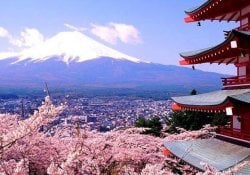In this article, we are going to look at one of Japan's most famous eras, the famous Edo Period ruled by the Tokugawa. In this article, we will fully analyze this period and how it affected Japan and the world in its long history.
Índice de Conteúdo
What do we need to know about the Edo Period?
It was in the Edo period that Japan entered an era of peace and national isolation. It was in this period that merchants were limited, Christianity was suppressed, the social hierarchy dominated and stabilized the country. The Edo period is famous for the Samurais, commercial and agricultural growth, the art of kabuki and bunraku theater, education and urban population.
The Edo period, also known as the Tokugawa period, is a period of japan history which was ruled by the shoguns of the Tokugawa family from March 24, 1603 to May 3, 1868. This period marks the rule of the Tokugawa Shogunate (or Edo Shogunate) which was officially established on March 24, 1603 by the first Shogun Tokugawa Ieyasu.
To clarify, the term shogun, (shōgun – 将軍) is literally Commander of the army. That was a military title and distinction during that time in Japan. It was granted by the Emperor himself. The Shogunate was a feudal regime until the modern age, similar to feudalism. In addition to being a landowner, the shogun was a military chief who was second only to the Emperor.
The Japanese name is Bakufu (幕府) literally meaning "government tent" (a military control), originally it is a shogun's house, but it ended up being used in Japanese to describe the military dictatorship, exercised by the shoguns.
Now that we've clarified these terms, we can get back to the main topic. The period ended with the Meiji Restoration on 3 May 1868, the restoration of tenno (emperor) rule by the fifteenth and final shogun, Tokugawa Yoshinobu. The Edo period is also known to mark the beginning of Japan's modern period.
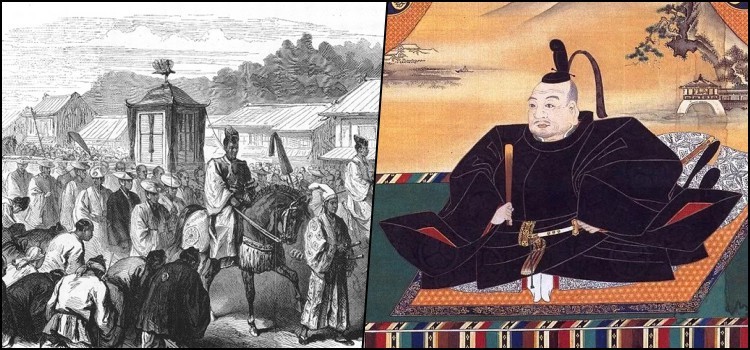
Oda Nobunaga and the reunification of Japan
During the Sengoku period (from the 15th to the 17th century), Japan suffered from gigantic political instability. Civil wars for land and power among the daimyo caused bloody waves. These wars contributed to the weakening of the central power of the Muromachi Shogunate, leaving everyone to himself, making it completely difficult to unite the country.
The reunification of Japan began to take shape with the campaign of Oda Nobunaga. He dominated Owari Province in 1559, then marched on the capital of Kyoto in 1568, restoring the power of the royal court (symbolically).
By dominating Kyoto, Nobunaga continues to eliminate his opponents, even a Buddhist sect called Ikko-ikki, destroying a monastery in 1575. With the introduction of firearms in the country, Nobunaga manages to defeat enemy peoples like the Takeda clan.
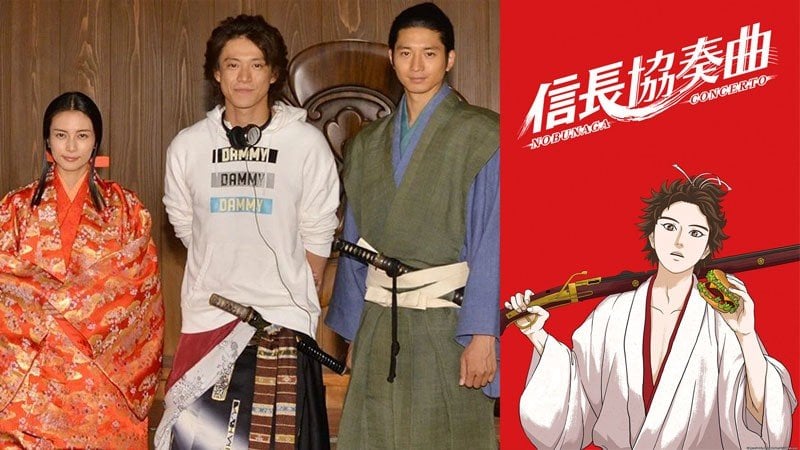
The Death of Oda Nobunaga
In 1582, Nobunaga is killed by one of his friends, Akechi Mitsuhide, who takes advantage of and usurps his master's place. Until General Toyotomi Hideyoshi, who was fighting alongside Nobunaga, quickly destroyed this rebellion, Mitsuhide's forces were wiped out and power regained.
With the support of Nobunaga's faithful, and the union of several daimyo, Hideyoshi continued with the reunification campaign, conquered the provinces of Kyushu and Shikoku, and finally defeated the last resistance, the Hojo family, who controlled Kanto. As a result, the military unification of Japan was completed.
The article is still halfway through, but we recommend also reading:
Edo period - Tokugawa Ieyasu
Tokugawa Ieyasu was instrumental in the rise of the new bakufu and the main beneficiary of the achievements of Oda Nobunaga and Toyotomi Hideyoshi. Ever powerful, Ieyasu profited from his transfer to the wealthy Kanto area. He maintained 2.5 million koku of land and a new headquarters in Edo (future Tokyo), a strategically situated castle town, and gained another two million koku of land and thirty-eight vassals under his control.
Destroying the forces that supported Hideyori in the Battle of Sekigahara, Tokugawa, without rivals at the time, managed to expand his domain throughout Japan, receiving from the Emperor, in 1603, the title of shogun, thus establishing the Tokugawa Shogunate.
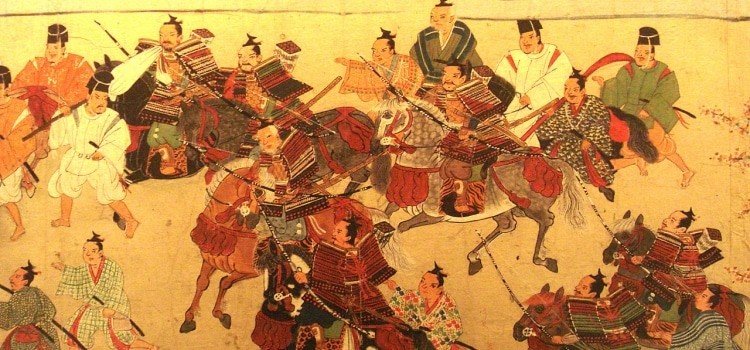
Edo Period - What is a koku?
The koku (石) is a unit of volume in Japan. 3.6 koku is equivalent to one cubic meter. Koku is historically described as enough rice to feed a person year round. (The equivalent measure of one person per day is masu). In 1891 one koku was changed and equated to 240100/1331 litres, which is equivalent to 180.39 litres.
After Hideyoshi's death, power was once again contested among the feudals. Ieyasu quickly moved to gain control of Japan and the Toyotomi family. He used his military and political power.
Edo Period - Tokugawa Shogunate
The Edo period, also called the Tokugawa, brought 200 years of stability to Japan. The system was called the bakuhan, a combination of the terms bakufu and han (dominions or fiefs). In the bakuhan, the daimyo had regional authority and the shogun national, this new system was very bureaucratic and complex.
The Tokugawa also had unprecedented power over the Emperor and all others below him. The Tokugawa helped the imperial family regain their past glories by rebuilding their palaces and giving them land. As a guarantee of a link between the imperial clan and the Tokugawa family, Ieyasu's granddaughter became imperial consort in 1619.
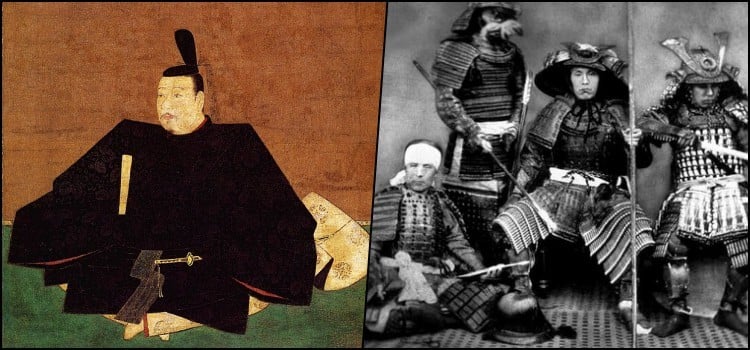
Political reforms in the Edo period
A code of laws was established to regulate daimyo houses. The code encompassed private conduct, marriage, dress, and types of weapons and number of troops allowed; mandatory rotating residency between Edo and the han (fief) from year to year (the Sankin kotai system); it prohibited the construction of ships capable of sailing in the open sea; banished Christianity; and stipulated that bakufu regulations were national law.
Although the daimyo were not officially taxed, they were regularly taxed with contributions for logistical and military support and for public works such as castles, roads, bridges, and palaces. The various regulations and taxation not only strengthened the Tokugawa, but also depleted the daimyo's wealth, consequently weakening them as a threat to the central administration.
Foreign trade during the Edo period
Ieyasu encouraged foreign trade but did not trust foreigners. He wanted to make Edo a major port city by favoring its ports, but once he observed that Europeans favored ports in Kyushu and that China had rejected his plans to establish official trade, he moved to take control of the trade. and allowed only certain ports to handle specific types of goods.
The Christian problem was, therefore, a problem of controlling both the Christian daimyos in Kyushu and their trade with Europeans. In 1612, the shogun's servants and residents in Tokugawa lands were ordered to repudiate Christianity.
Further restrictions came in 1616 (the restriction of trade with foreigners to be carried out only on Nagasaki and Hirado, an island northwest of Kyushu), 1622 (the execution of 120 missionaries and converts), 1624 (the expulsion of the Spaniards), and 1629 (the execution of thousands of Christians).
Finally, in 1635, an edict prohibited any Japanese from traveling outside Japan or, if one left, from ever returning. In 1636 the Dutch were restricted to Dejima, a small artificial island – not officially Japanese soil – in Nagasaki Inlet.
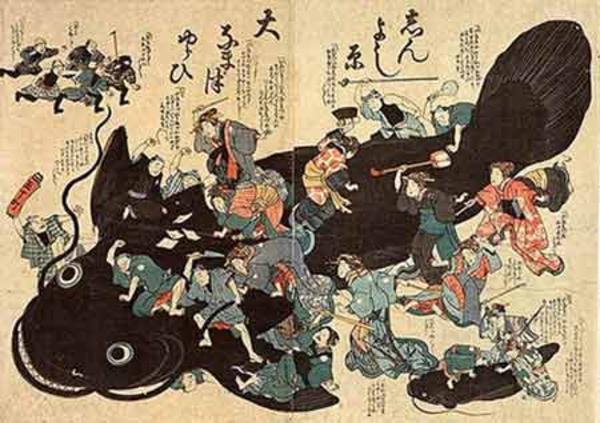
Edo period - Shogunate x Christianity
The shogunate regarded Christianity as a major destabilizer, resulting in the persecution of Catholicism. Between 1637-1638) the Shimabara Rebellion took place, in which samurai and Catholic villagers rebelled against the bakufu. Until Edo asked Dutch boats for help and they bombed the rebel stronghold, thus marking the end of the Christian movement.
By 1650, Christianity was almost completely eradicated, any outside influence on Japan's politics, religiosity, and economics ended. Only China and the Dutch India Company had the right to visit Japan during this period, for commercial purposes only, and they could only go to the port of Dejima in Nagasaki, otherwise it was death.
After this incident, the Portuguese were expelled, members of the Portuguese diplomatic mission were executed, all subjects were ordered to register at Buddhist or Shinto temples, and the Dutch and Chinese were restricted to a specific part of Nagasaki.
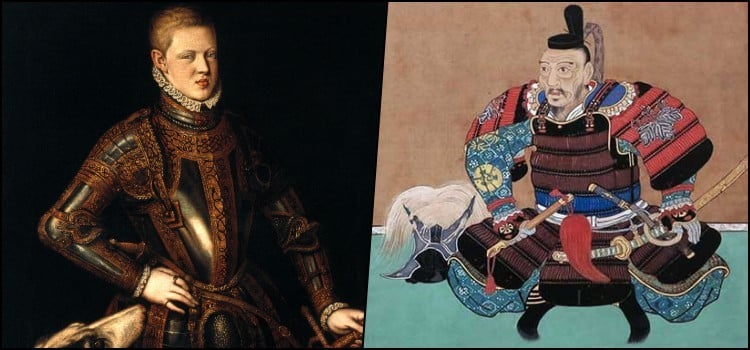
Edo period development
Economic development during the Edo period included a gigantic increase in urbanization, shipping of goods, expansion of domestic, industrial and artisanal trade. The construction trade grew, alongside banking businesses and merchant associations. Han authorities managed agricultural production and rural crafts as it grew.
In the 18th century, Edo already had a population that exceeded one million inhabitants, while Osaka and Kyoto had about 400 thousand inhabitants. Many other castle towns also grew. Osaka and Kyoto became centers of craft production and commerce, while Edo was the center of urban supplies and goods.
In the Edo Period, Japan studied Western sciences and techniques (an act called rangaku or Dutch studies) through the books and information that Dutch traders brought to Dejima. Geography, natural sciences, medicine, astronomy, languages, arts, physical sciences, electrical and mechanical sciences were studied by the Japanese for development in several areas.
Neo-Confucianism was the main development of the Tokugawa period. Confucian studies were kept active among Buddhist clerics but expanded into a secular view of man and society. Ethical humanism, rationalism, and neo-Confucian doctrine were attractive to government officials. In the 17th century, Neo-Confucianism was the dominant philosophy in Japan and contributed to the school development kokugaku (of thought).

Consequences of rangaku for the population
Studies in mathematics, astronomy, cartography, engineering, and medicine were also encouraged. An emphasis was placed on the quality of craftsmanship, especially in art. For the first time, urban populations had the means and the free time to support a new mass culture.
The pursuit of fun became known as ukiyo-e ("the floating world"), an ideal world of fashion and popular entertainment. Professional female artists (geisha), music, folk stories, Kabuki and bunraku ("puppet theater"), poetry, and a rich literature, and art, exemplified by woodblock print work (known as ukiyo-e), they were all part of this flourishing culture. Literature also flourished with notable examples of the playwright Chikamatsu Monzaemon (1653-1724) and the poet, essayist, and traveling writer Matsuo Basho (1644-1694).
Ukiyo-e prints began to be produced in the late 17th century, but in 1764 Harunobu produced the first polychrome print. Next-generation print designers, including Torii Kiyonaga and Utamaro, created elegant and sometimes judicious depictions of courtesans.
In the 19th century, the dominant figure was Hiroshige, a creator of romantic and somehow sentimental landscape prints. The odd angles and ways in which Hiroshige often depicted landscapes, and the works of Kiyonaga and Utamaro, with their emphasis on flat, strong surfaces, linear contours, later had a profound impact on Western artists such as Edgar Degas and Vincent van Gogh.
Edo period religion
Buddhism and Shinto were very important in Tokugawa Japan. Buddhism, combined with Neo-Confucianism, provided the standards for social behavior. While not as politically powerful as it once was, Buddhism was supported by the upper classes. Prohibitions against Christianity benefited Buddhism in 1640 when the bakufu ordered everyone to register at a temple.
The strict separation of society in the Tokugawa government into hans, villages, garrisons, and family home helped to reaffirm local Shinto ties. Shinto provided the spiritual support for the political order and was an important bond between individuals and the community. Shintoism also helped to preserve a sense of national identity.
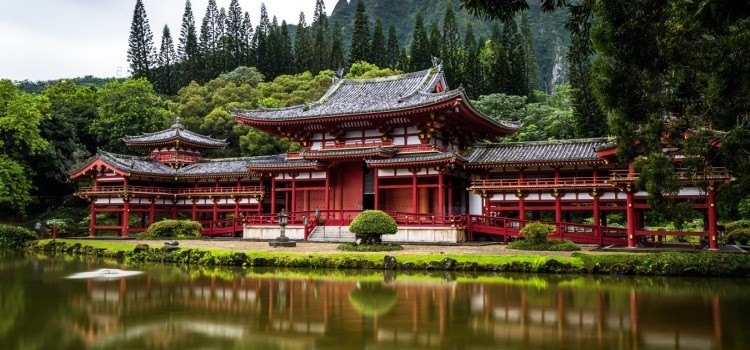
End of the Shogunate – Main reason
The end of this Edo period is called the late Tokugawa Shogunate. The end of the period and its cause is controversial, but it is believed that it was westernization and the US Navy's open doors that started the end. Matthew Calbraith Perry's armada, known as black ships by the Japanese, carried out several shots with their guns in Tokyo Bay.
Artificial islands were created to block the range of weapons, becoming today what we know as Odaiba. The foreign intrusion helped to precipitate a complex political struggle between the bakufu and their critics, a result of Tokugawa mismanagement. The anti-bakufu movement in the mid-19th century brought the Tokugawa to an end.
End of the Shogunate – Merits of the Shogunate
From the beginning, the Tokugawa tried to restrict the accumulation of wealth by Japan's families and endorsed a "back to the land" policy, in which the farmer, the ideal producer, was the "ideal citizen" to be achieved in society. Despite efforts to restrict wealth, and partly due to the extraordinary period of peace, the standard of living of both urban and rural inhabitants rose significantly during the Tokugawa period.
Improvements in the means of crop production, transportation, housing, food, and entertainment were available, as well as more leisure time, at least for the urban population.
The literacy rate was high for a pre-industrial society, and cultural values were redefined and widely disseminated across the samurai and chonin classes. Despite the reappearance of guilds, economic activities went well beyond the restrictive nature of guilds, and trade spread and the money economy developed.
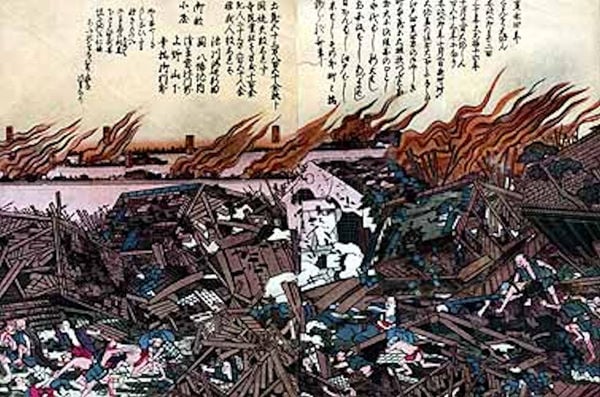
End of the Shogunate – Failure
A dispute arose in the face of the political constraints that the shogun had imposed on the entrepreneurial classes. The governmental ideal of an agrarian society failed to fit in with the reality of commercial distribution.
The great government bureaucracy had evolved, and had stagnated due to its discrepancies with a new social order that was constantly changing. Combined with the situation, the population had increased significantly during the first half of the Tokugawa period.
Although the rate and magnitude of growth is uncertain, there were at least 26 million citizens and approximately 4 million members of samurai families and their serfs when the first census was taken in 1721. Droughts, followed by crop failure and famine, resulted in 20 great famines between 1675 and 1837.
End of the Shogunate – Crisis
People's dissatisfaction grew, and by the end of the 18th century, protests over taxes and lack of food had become frequent. Families who lost their land became tenant farm families (they worked on land owned by other people), while poor rural inhabitants who had nowhere to live moved to the cities.
As the fortunes of working families declined, others moved quickly to accumulate land, and a new and wealthier class of farmers emerged. Those who benefited were able to diversify their production and hire labor to support themselves, while others were left to discontent.
End of the Shogunate – Invasions
Although Japan managed to acquire and improve a wide variety of scientific knowledge, the rapid industrialization of the West during the 18th century created for the first time a material gap in terms of technology and weaponry between Japan and the West (which did not really exist at the beginning of the Edo period), forcing the government to abandon its seclusion policy which contributed to the end of the Tokugawa regime.
Western intrusions were increasing in the early 19th century. Russian warships and commerce ships invaded Karafuto (called Sakhalin under Russian and Soviet control) and the Kuril Islands, the southernmost part of what is considered by the Japanese to be the northern islands of Hokkaido.
Although the Japanese made small concessions and allowed some landings, they still vehemently tried to keep foreigners out, sometimes using force. Rangaku became crucial not only for understanding the “barbarian” aliens, but also for using the knowledge gained from the West to drive them out.
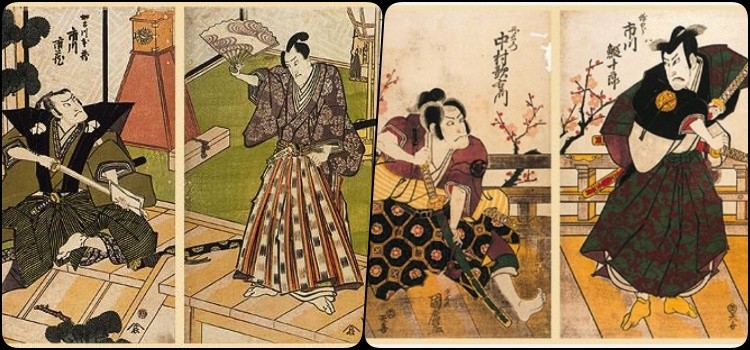
End of the Shogunate - Despair
In 1830 there was a crisis because of widespread famine and several natural disasters that shook the population. They were dissatisfied and rebelled against government officials and Osaka merchants in 1837. The revolt lasted only a day, but the consequences were visible.
Many sought to reform morals rather than focusing on the country's institutional problems. The shogun's advisers called for martial spirituality, restrictions on trade with the West, censorship of literature, and the elimination of "luxury" in the samurai class.
Others wanted to depose the Tokugawa and support the political sleep joi (honor the emperor, drive out the barbarians). Despite this, the bakufu managed to hold its own despite opposition and increasing commercialization with Westerners after the First Opium War of 1839-1842.
End of the Shogunate – Final Moments of Seclusion
In 1853 the United States arrived in Edo Bay demanding the opening of Japanese ports. In 1854, the Treaty of Kanagawa (Peace and Friendship) was signed, which granted the opening of 2 ports to American ships. They were entitled to supplies, support for castaways and a consul's abode at Shimoda in southwest Edo.
Five years later, other ports were opened to the US due to treaties, indicating the beginning of the shogunate's decline in power. This process caused massive damage to the bakufu. Debates about the shogunate surfaced for the first time among the population, causing great criticism of the government.
End of the Shogunate – Instability and Displeasure
To contain the political instability, Abe tried to win new allies to his cause by consulting the shinpan and tozama clans, to the surprise of the fudai (clans closest to the Tokugawa), a situation that further destabilized the already weakened Bakufu.
Pro-imperialist ideals grew mainly through the propagation of schools of education, such as the Mito School — based on neo-Confucian and Shintoist teachings — which aimed at the restoration of the imperial institution, the withdrawal of Westerners from Japan and the creation of an Empire. world about the divine Yamato dynasty.
In the midst of these political and ideological conflicts, Tokugawa Nariaki was put in charge of national defense in 1854. Nariaki had long embraced anti-foreign ideals and a military loyalty to the Emperor, thus becoming one of the main leaders of the anti-shogunate faction and later playing an important role in the Meiji Restoration.
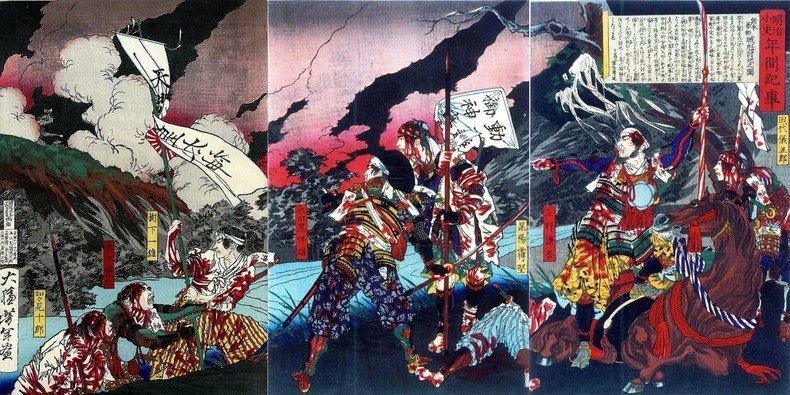
End of the Shogunate – End of Seclusion
In the final years of the shogunate, foreign relations increased and more concessions were made. A new treaty with the United States in 1859 allowed more ports to be opened for diplomatic representatives. In the same year, unsupervised trade was allowed in 4 more ports and the construction of foreign residences in Osaka and Edo. The same treaty incorporated the concept of extraterritoriality (foreigners were subject to the laws of their respective countries, not Japanese law).
When the shogun Iesada died without heirs, Nariaki appealed to the court for the support of his son, Tokugawa Yoshinobu (or Keiki), for shogun, who was favored by the daimyo of the shinpan and tozama clans.
However, the fudai won the power struggle, instituting Tokugawa Yoshintomi as shogun, arresting Nariaki and Keiki, and executing Yoshida Shoin (1830 – 1859, a leading sonnõ-jôi intellectual who had been against the American treaty and had engineered a revolution against the bakufu), and signed treaties with the United States and five other nations, thus ending more than 200 years of seclusion.
End of the Shogunate – Militarization
During the bakufu's last years, extreme measures were taken in order to regain its political dominance, although its involvement with modernization and foreign powers made it the target of anti-Western sentiments throughout the country.
The army and navy were modernized. A naval training school was built in Nagasaki in the year 1855. Naval students were sent to study in Western schools for several years, thus starting a tradition of sending future leaders to study in the West, such as Admiral Enomoto. French naval engineers were commissioned to build a naval arsenal, such as the Yokosuka and Nagasaki arsenals.
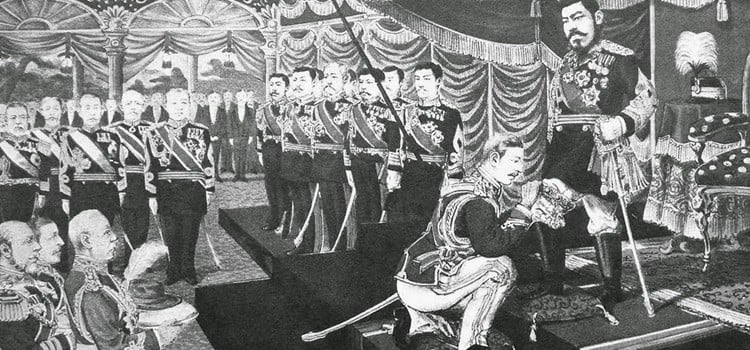
Late Tokugawa Shogunate
The Late Tokugawa Shogunate or Last Shogun was the period between 1853 and 1867 during which Japan ended its isolationist foreign policy, called sakoku, and modernized itself from a feudal shogunate to the Meiji Government. This period is at the end of the Edo Era, preceding the Meiji Era.
The main ideological/political factions during the period split into pro-imperialist Ishin Shishi (nationalist patriots) and shogunate forces, including the elite Shinsengumi (newly selected army corps) of swordsmen. Although the two groups were the most visible strength, many other factions tried to use the Bakufu's chaos in an attempt to gain personal power.
Extremists against the West
Emperor-worshipping extremists incited death and violence against the authorities of the bakufu, hans (fiefs) and western foreigners. In the Anglo-Satsuma War, there was a naval retaliation that led to the creation of another concessional trade treaty in 1865, but it was not fulfilled. Soon after, an army of bakufu was eliminated in an attempt to crush rebel groups in the hans of Satsuma and Choshu (1866). In 1867, the emperor died and was replaced by his son Mutsuhito.
Keiki (Tokugawa Yoshinobu) despite being reluctant, became leader and Shogun of the Tokugawa household. He tried to arrange the government under the Emperor's influence and preserve the shogun's political power. Afraid of the power of the Satsuma and Choshu clans, other daimyo supported the return of the shogun's powers to the Emperor and a Tokugawa council.
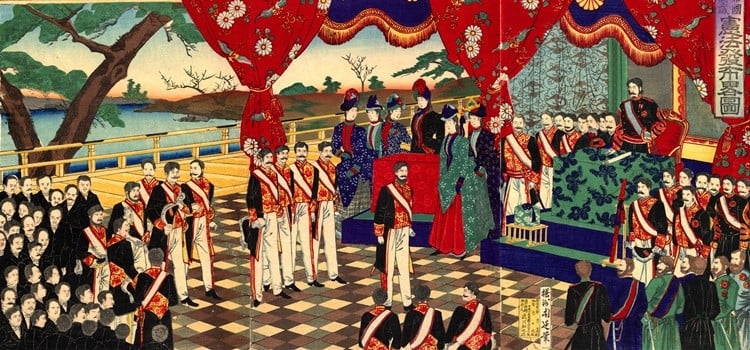
Boshin War
The Boshin War ("War of the Year of the Dragon") was a civil war in Japan, fought from 1868 to 1869 between government forces of the Tokugawa shogunate and those favoring the restoration of the Meiji Emperor. The war finds its origins in the emperor's declaration of the abolition of the 200-year-old shogunate and the imposition of direct command of the imperial court.
Military movements by imperial forces and partisan acts of violence against the empire in Edo prompted Tokugawa Yoshinobu, the shogun, to launch a military campaign to control the imperial court in Kyoto. The military tide quickly turned in favor of the small but relatively modernized imperial faction, and after a series of battles culminating in the surrender of Edo, Yoshinobu personally surrendered.
Following the Boshin War the bakufu was abolished, and Keiki was reduced to the level of a daimyo. Shogunate resistance movements continued in the north following the year 1868, and the naval forces of the bakufu, under the command of Admiral Enomoto, held out for over 6 months in Hokkaido, where they founded the Republic of Ezo, which had a short period. of existence.
Keiki accepted the plan in late 1867 and abdicated, heralding an "Imperial restoration". But on January 3, 1868, leaders of the Satsuma, Choshu, and other Hans took over the Imperial Palace and announced their own restoration. Political and military powers were restored to the Emperor, thus ending more than 200 years of Tokugawa rule over Japan.
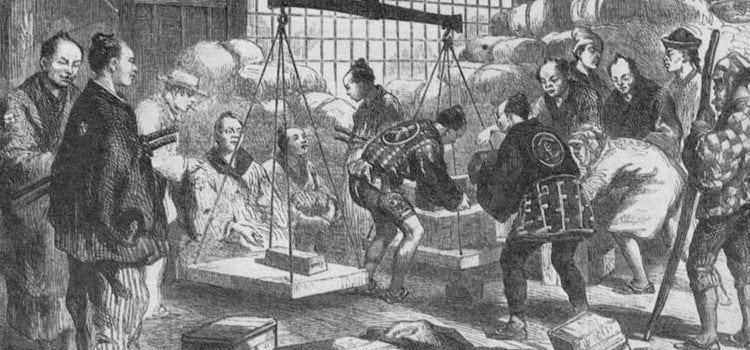
Conclusion and my opinion
If you ask me what the consequences of this period for the history of Japan, I would certainly answer that it was one of the most important in history, followed by the Meiji revolution, the Edo period brought to Japan an incredible development both in the industrial part and in the philosophical part. .
This statement is ironic, but this period of isolation has helped a lot, with some aspects of Japan. For example, the great sense of patriotism and cooperation they have. After all, Japan is famous for its helpful and thoughtful people, as well as its highly disciplined and motivated workforce.
I believe that, however, it left serious consequences, as is the case of people's reclusion and distrust of Westerners. I don't think we can judge them, because as an example we have the Second World War, which even we Brazilians are morally and culturally affected by it. Of course its effects diminished over time however if we were to take a look at our older relatives, I believe that almost all or most have bad impressions of it, even if they were not directly affected by it.
If we are going to compare these 200 years with the Second World War, I believe that we can derive from this comparison a basis for knowing the effect they had on that country. However, we know that nothing lasts forever, and for that reason the effects of these two events have diminished. Anyway I think it doesn't affect as much as it did a while ago, but some of its effects are lasting or at least more persistent.
That's all for today, it was a great article, however we have to take into account that we studied a period of great importance in the history of the Japanese, so I couldn't save words. OK, thank you, my dear reader, for reading this far. And any doubt, suggestion or criticism just comment, we will always be reading the comments. Don't forget to vote.






